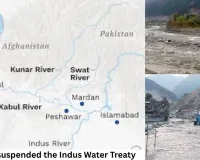How Cyclone Montha, Meaning 'Fragrant Flower,' Turned into a Dangerous Storm
Digital Desk
The name 'Montha,' meaning a fragrant flower in the Thai language, belies the destructive nature of the severe cyclonic storm that recently made landfall in India, underscoring the complex system of naming these powerful natural phenomena.
The severe cyclonic storm 'Montha' made landfall on Tuesday, crossing the Andhra Pradesh coast between Machilipatnam and Kalingapatnam, to the south of Kakinada.
Despite its gentle name, the storm has brought significant disruption, claiming at least one life, unleashing heavy rains, and causing the evacuation of approximately 76,000 people in Andhra Pradesh alone as part of large-scale relief operations.
How Do Cyclones Form?
Cyclones are powerful atmospheric systems that develop over warm tropical oceans. Their formation and strength are strongly correlated with sea surface temperature (SST).
- The Warm Ocean Fuel: When sea temperatures regularly exceed 26°C to 30°C, they create an ideal environment for cyclone formation. As water gets warmer, latent heat energy increases, which provides the energy needed for a storm to intensify.
- The Role of a Warming World: Meteorologists attribute the increasing intensity of storms to global warming. A warmer atmosphere has a greater capacity to hold moisture, which leads to heavier rainfall during cyclones and intensified wind speeds. Studies have indicated that the sea surface temperature in the Bay of Bengal has risen by 0.5°C to 1°C in the last 50 years.
Who Names Cyclones?
The process of naming cyclones is designed to ensure clear and efficient communication between scientists, disaster managers, and the public.
In the North Indian Ocean, the task is coordinated among 13 countries, including India, Bangladesh, Myanmar, Pakistan, Thailand, and others. Each country contributes a list of names, which are then used in alphabetical order as cyclones form. The name 'Montha' was contributed by Thailand, reflecting a regional agreement to name cyclones from a pre-approved list.
This system ensures that names are short, easy to pronounce, and free of any political, religious, or cultural bias.
A Trend of Increasing Intensity
Cyclone Montha fits a pattern of recurring high-intensity storms affecting the eastern Indian coastline. Since 2008, approximately 70 cyclonic storms have made landfall from both the eastern and western coasts of India.
The Bay of Bengal is one of the world's most active cyclone zones, and climate change is a key factor in this activity. Positive IOD (Indian Ocean Dipole) and La Niña conditions, which involve a warmer Indian Ocean and cooler Pacific, contribute to more favourable conditions for cyclonic formations.
Furthermore, deforestation and the degradation of coastal ecosystems like mangroves have reduced natural buffers, amplifying the damage caused when these storms make landfall.
As Cyclone Montha weakens and moves inland, it serves as a potent reminder of the dynamic and often destructive power of nature, a power that is increasingly influenced by a changing climate.











